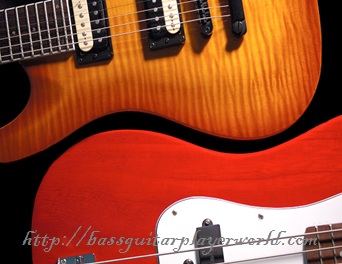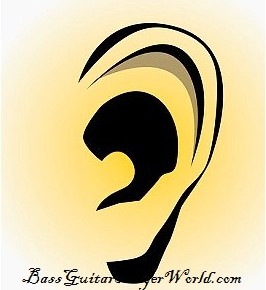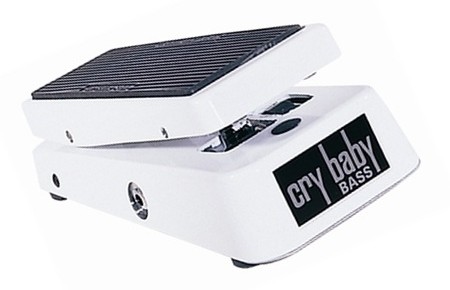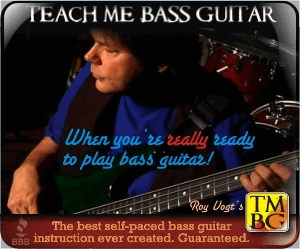Jazz Bass Lessons

Scroll downwards to see lessons…
Every style has its beginning –even a musical style as complex as jazz has a starting point. Very few musicians are simply born with the ability to play jazz. Those who do are lucky. For the rest of the world (about 99% of it) who wish to play jazz, they must start from the ground up.
In this article, we’ll help you to build those basic foundations to get you ready for a lifetime of musical bliss with jazz bass guitar playing.
Jazz is an extremely broad style of music. Next to heavy metal, it is one of the most expansive of genres in modern music. This is because jazz playing can be interpreted into many forms. All jazz forms have a few things in common, however, and we’ll go over these things.
Seventh Chords
These are the most popular chords in jazz. This is due to the fact that seventh chords all have a slight hint of dissonance, some more than others. Dissonance gives off an unstable, ethereal sound, and this creates atmosphere and the need for resolution. When used correctly, sometimes seventh chords can be used throughout an entire piece without ever being resolved.
Seventh chords are built off of triads. Triads are the foundation of every real chord in music. There are four types of triads; major, minor, diminished, and augmented.
Major triads are built of a major third followed by a minor third. Minor triads are built of a minor third followed by a major third. Diminished triads are formed by two consecutive minor thirds, and augmented triads are formed of two consecutive major thirds.
Every triad consists of three things; a root, a third, and a fifth. A seventh chord is simply a triad with an added interval, either a major or minor third, which creates an interval of a seventh.
Chromatic Scales
 No musical style makes as much use out of the chromatic scale as jazz music. In fact, entire jazz pieces have been crafted from the chromatic scale. Learning how to play jazz bass can really open up your eye to new boundaries of creativity.
No musical style makes as much use out of the chromatic scale as jazz music. In fact, entire jazz pieces have been crafted from the chromatic scale. Learning how to play jazz bass can really open up your eye to new boundaries of creativity.
The reason that so many musical styles avoid the chromatic scale is that it seems so unstructured; it covers the entire fret board.
With that, there are no set patterns to follow, only half step intervals. This is an enormous challenge, and many musicians simply cannot grasp the concept of such a broad scale. Jazz musicians however tend to utilize the chromatic scale. It is a scale without bounds, and allows for vast experimentation.
Improvisation
Many jazz pieces are built solely upon improvisation. This is where the chromatic scale becomes so handy; it allows you to play within a key without restricting yourself to the set of notes involved within the specific key.
The key skill is to learn how to stay within a ‘box.’ This means to stay within a certain position on the neck and be able to organize and reorganize notes to create different patterns.
Bass improvisation is an important skill to learn, and jazz music makes full use of it.
Hopefully this article, gives you a bit more view into the world of jazz. These are the most common concepts you will come across, so it is best that you acquaint yourself with them before tackling jazz bass guitar.
List of Free Jazz Bass Lessons:
#1 – Bass Lines And Concepts You Need to Master
In this tutorial, we will teach you a few jazz bass lines that makes use of chromatic notes as well as the use of chord movements for your playing. Let’s have some fun and learn something new at the same time.
#2 – Jazz Blues 12 Bar Progression That Musicians Commonly Use
This is an essential lesson for all jazz bassists as we take a look at the commonly found twelve bar blues/jazz progression. If you are into this particular style, this is a stepping stone for entry.
#3 – Learn How to Do Improvisation Correctly And Sound Like a Pro
If you like to improvise and want to apply your skills as you jam along with your friends, this tutorial is a must-read. Whether you are a beginner or a seasoned musician, there are insights here you don’t want to miss.
#4 – Fire Away With These Soloing Ideas!
One of the most crucial elements of a bass solo is to decide what goes into it. In jazz playing, there are a huge variety of techniques that you can use to spruce up a solo. How do you decide and come out with ideas for it? Read this tutorial to find out.
#5 – Augmented Arpeggios Theory And Application to Practical Usage
While the term augmented arpeggios may sound like a mouthful, the logic behind them is rather simple. Essentially, we are taking an augmented chord and breaking it up into individual notes to be played sequentially.
#6 – Melodic Phrasing That Will Enable You to Mesmerize the Crowd
Phrasing in bass playing is very important to emphasize and highlight a melody when done correctly. In this lesson, we will teach you how to do this properly without becoming an overkill.
#7 – Role of the Bass Guitar in Jazz Genre Music
Have you ever wondered what the role of the bassist is in the jazz genre? Unlike many other musical styles, the bass player in a jazz band gets more limelight and plays a vital role in bringing out the flavor of the style.
#8 – Find Out What Exactly Are Accidentals And Double Accidentals
When you are reading through a piece of sheet music, you may occasionally come across symbols like # or b in the staves. These are accidentals. What are they and what do they mean?
Fast Track Yourself to be a Master Bassist
Teach Me Bass Guitar is the most comprehensive, effective and entertaining program available anywhere outside of a major music school. Whether you are a new player or someone who had been playing for years, this course covers everything!
From basics to advanced techniques like slapping, to modes and essential theory, it is exactly what you need for success! For a limited time, get a WHOPPING 25% off the massive course…
Related Articles
Comments are closed.






